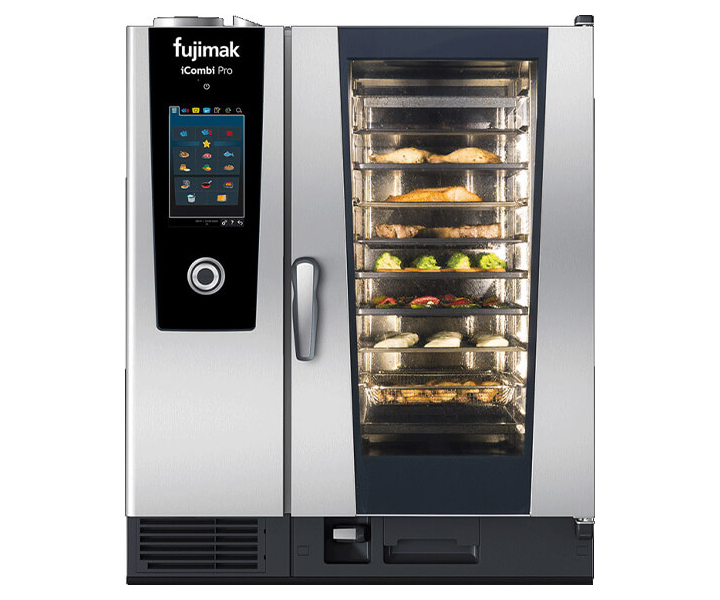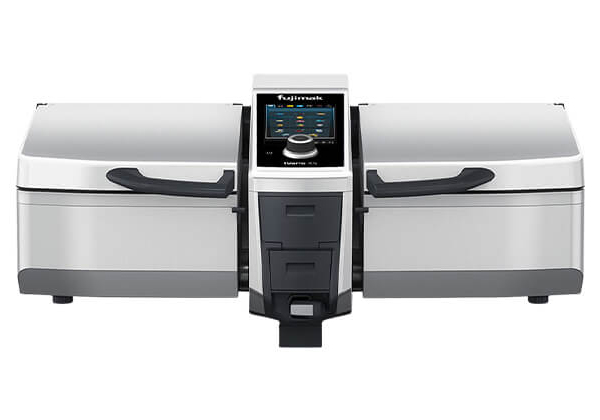Example CustomerMaison KEI

Photo by Takehiro Goto
A functional kitchen to focus on creativity
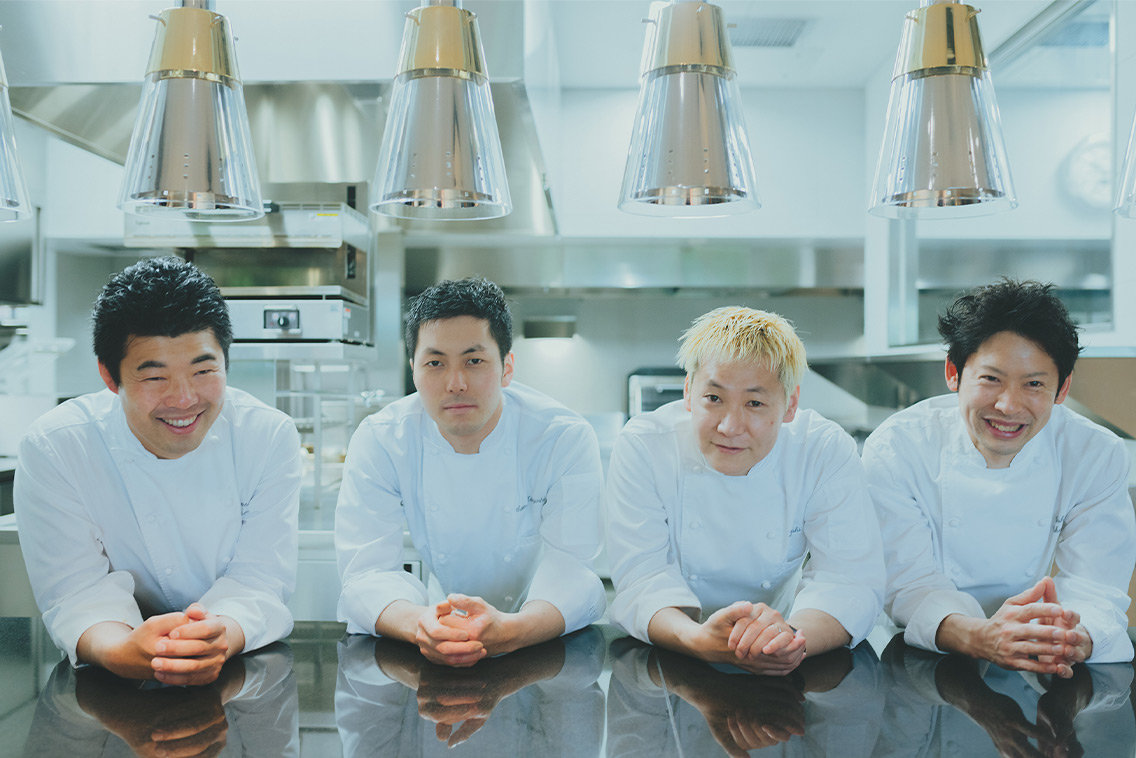
- From left: Sous Chef Inazawa (Restaurant KEI), Chef Sato (Maison KEI), Owner-chef Kobayashi (Restaurant KEI), and Chef-patissier Takatsuka (Restaurant KEI).
“Toraya,” a long-established Japanese confectionery shop, and "Restaurant KEI," a three-star Parisian restaurant, partnered to open the French restaurant in January 2021. Chef Kei Kobayashi, who became the first 3-star chef from Asia in 2020, serves an impressive array of dishes prepared with care and using rich local ingredients in Gotemba at the foot of MT. Fuji. Fujimak designed and built the kitchen used to prepare these dishes.
A cook should also be a cleaner
Chef Kei Kobayashi of Restaurant KEI became the first Asian chef to receive three stars in the MICHELIN Guide France 2020 last year. He partnered with “Toraya,” one of Japan's most historic Japanese confectionery shops, to open a French restaurant. The origins of this unexpected combination can be traced back to when Mitsuharu Kurokawa, the 18th-generation owner of Toraya, was working in Paris. He was impressed with Chef Kobayashi, who was getting ready to open Restaurant KEI at the time, and they stayed in touch, which eventually led to the creation of Maison KEI.
The Maison KEI project has been in the works for a long time, with concept beginning five years ago. However, Chef Kobayashi and Chef Mitsuyoshi Sato, who was entrusted with Maison KEI, were only able to meet face-to-face with Fujimak staff once or twice a year. However, they were able to complete the project by discussing the finer details of their needs over the phone, in writing, and via email.
Chef Kobayashi's top requirement for kitchens is “ease of cleaning.” He says, “A cook should also be a cleaner. But it is not the act of cleaning itself but the final cleanliness that is important. Ideally, however, cleaning should take as little time as possible to finish. If you could save an hour of cleaning each day, think how much more time you could spend cooking each year or how much more time you could spend on creative work. That's why ease of cleaning is so important.”
To fulfill this request, the floor was designed with a concrete base that prevents dirt and water from getting under equipment. The worktops on cooking equipment are also formed as a single piece with no joints.
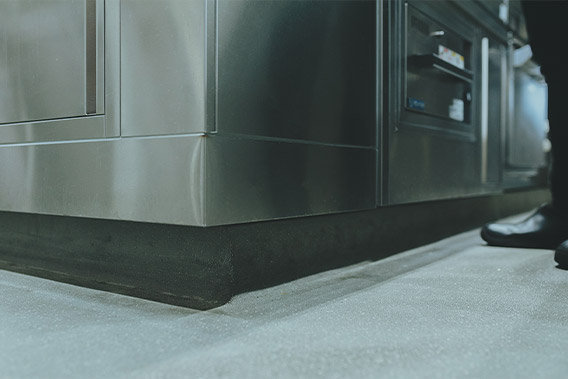
- Concrete base design:
Chef Kobayashi places such importance on cleaning that he says, “A cook should also be a cleaner.” That is why the design prioritizes ease of daily cleaning. The kitchen counter and flooring Installation method is specced with a concrete base that prevents dirt and water from getting under equipment.
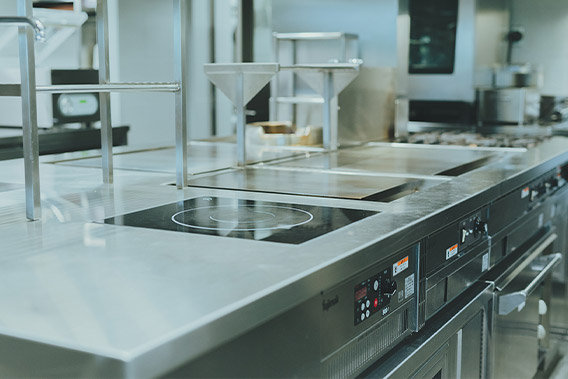
- Seamless worktops:
A stainless steel worktops was custom-ordered to the standard overseas thickness of 2 mm. They were also formed as a single piece to meet Chef Kobayashi's request for “ease of cleaning.”
Installed the same combi oven as used in Paris
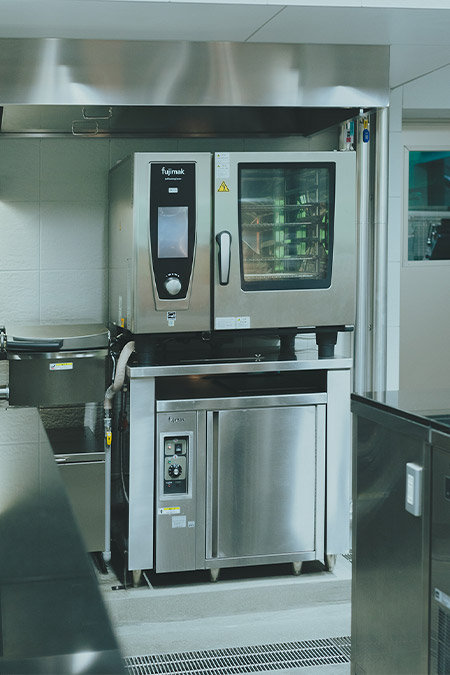
- Combi oven:
The same combi oven used at Restaurant KEI in Paris was installed two pieces as trusted cooking equipment, the one for hot dishes and cold dishes, the other for baking confectionery. The combi oven combines the function of blast chiller for cooking with the function of a proofing cabinet for baking confectionery. “The temperature control is very precise, and the automatic cleaning function is also helpful,” says Chef Kobayashi.
As with cleaning, the "flow line" is also important. Chef Kobayashi says, "If the flow line is not good, it's like losing one or two valuable personnel, which affects the quality of the entire restaurant. That's why I asked them to start designing the building from the kitchen and allow the rest of the design to flow from there."
According to Yuki Takahashi (Design Department Manager, Tokyo Sales Division), who was in charge of the design, "It's quite rare in Japan to design a restaurant with the kitchen as a top priority."
But thanks to this, the resulting restaurant has no pillars, making it feel much larger than a typical restaurant. The kitchen, whose necessary equipment was arranged after carefully considering the flow lines of the cooks, allows the staff to move about easily.
Of his many cooking appliances, Chef Kobayashi has a special fondness for the "combi oven."
"We use the same model we used in Paris," Chef Sato explains, "and using the equipment I used in Paris is reassuring because I know it has reliable temperature control, good air circulation, and good automatic cleaning." He adds, "With its stable oven temperature, I can get the perfect amount of browning. It is useful not only for baking but also for 'vapeur' (steaming)."
According to Toshiya Takatsuka, chef/patissier at Restaurant KEI, who traveled from Paris to support the project, "Because there is no unevenness in baking, the six internal baking sheets do not need to be shuffled, allowing the inside temperature to remain stable. The automatic cleaning system is quite thorough and even removes chalky residue that can cause malfunctions. This not only eliminates the cleaning work that used to take about an hour each week but also cleans more accurately than manual cleaning, which is a huge benefit. Thanks to this, we have more time to devote to coming up with and trying out new recipes. I haven't even mastered some functions yet, which means there are even more possibilities."
The realization of Chef Kobayashi's vision
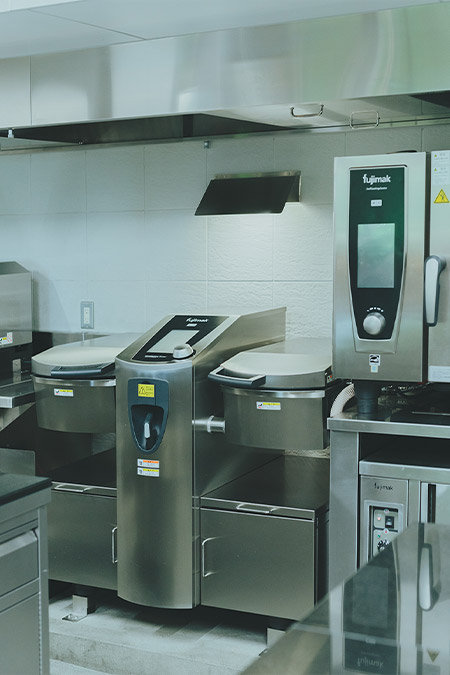
- Vario Series Dual Pan:
The Vario Series Dual Pan is a multifunctional appliance that can boil, bake, fry, simmer, deep-fry, and pressure cook. Chef Sato, who uses the Vario Series Dual Pan on a daily basis, says, "It allows me to brown meat and then add water to braise it, handling the whole process in one step." He also praised its convenience, saying, "It's also nice to be able to use two pans for different tasks at the same time."
After trying out the Vario Series Dual Pan at the Fujimak showroom during his visit to Japan, Chef Kobayashi decided to have it installed.
He said, "During restaurant hours, I can cook in one pan while preparing sauces in the other. I think this equipment offers a wide range of applications."
When asked why Fujimak was selected to design and build Maison KEI, Chef Kobayashi replied, "It was the result of researching the chefs around me with whom I interacted. It's like buying a car. You can buy it based solely on liking it without ever driving it, or you can buy it based on the actual opinions of those who have driven it. When it comes to kitchens, practicality is important, so I talked to chefs who use Fujimak equipment for their opinions. Since chefs spend most of their day in the kitchen, I want to make it as easy as possible to work in, including all the necessary equipment and a streamlined workflow. That's why I chose Fujimak."
Takahashi, who was in charge of identifying and realizing Chef Kobayashi and Chef Sato's ideas, says,
"Because they were so well versed in French methods, they had many detailed requests that differed from Japanese standards, and we looked for ways to accommodate each of them. It was one of the most difficult projects I'd ever worked on."
However, according to Chef Kobayashi, Maison KEI is far from finished, and he has only just begun with plans for future expansion. He will continue to make upgrades to create an even more user-friendly kitchen that allows chefs and patissiers to focus on their work.
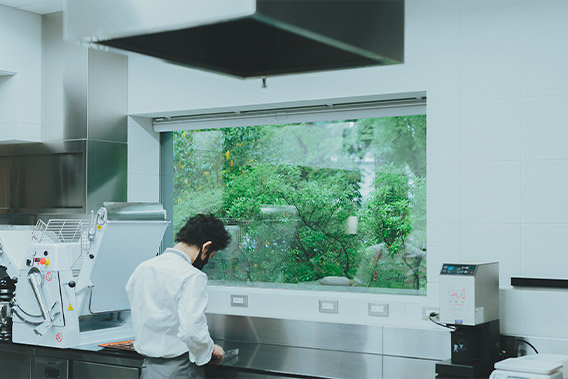
- Window in front of the confectionery space:
A large window sits in front of the patissier's workspace. Chef Kobayashi explains how his ideas were integrated, saying, "Since the restaurant is located in a beautiful natural setting, it would be a shame not to feel the changing seasons while working. Patissiers, in particular, should be able to see the four seasons. Seeing the natural light and the vitality of trees helps to stimulate the senses and inspire a sense of color."
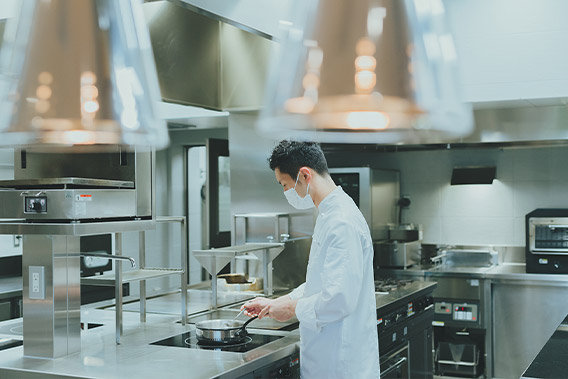
- Chef Sato cooking:
In addition to heating equipment such as the Vario Cooking Center, combi oven, induction heating (IH) stove, salamander, griddle and also bakery equipment, the kitchen includes a pizza oven and Chinese range, which are rarely seen in French restaurants. Chef Sato says, "The pizza oven heats up to over 300 degrees, which is great for crispy finishes, while the Chinese range can also be used for stir-frying, which allows us to serve a side dish, such as fried rice, for those who want a little more than the set course."
Related Products
Chef Kei Kobayashi - Profile
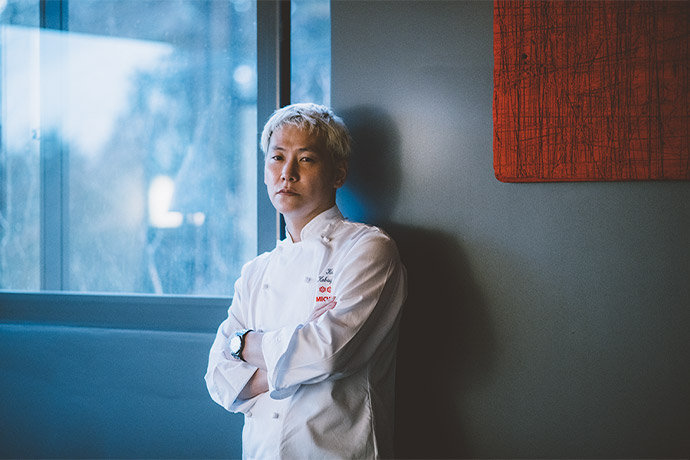
Photo by Takehiro Goto
Born in Nagano Prefecture. Moved to France after training to be a chef in Nagano and Tokyo. Moved to Paris after studying the rich culinary traditions of renowned restaurants in southern France and Alsace. Worked at Alain Ducasse's restaurant, “Alain Ducasse au Plaza Athénée,” in Paris for seven years. Became a sous chef in his third year. Opened Restaurant KEI as owner-chef in Paris in March 2011. Was awarded three stars in the MICHELIN Guide France in January 2020. Continued to receive three stars in 2021.
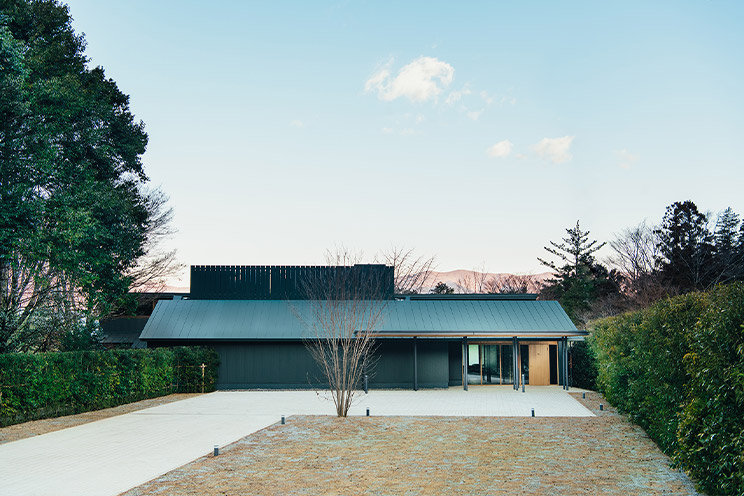
- The restaurant is situated in the Gotemba forest at the foot of Mt. Fuji.
| Restaurant name |
Maison KEI |
|---|---|
| Address | 527-1 Higashiyama, Gotemba City, Shizuoka Prefecture |
| Phone | 0550-81-2231 |
| Business hours |
Lunch: From 11:30am Dinner: from 5:30pm |
| Closed | Tuesdays, Wednesdays |
| Menu | Lunch Course (excluding tax and service charge): 4,500 yen (4 dishes), 8,500 yen (6 dishes) Dinner course (excluding tax and service charge): 5,500 yen (4 dishes), 9,000 yen (6 dishes) |
| Capacity | 40 seats |
| Website | https://www.maisonkei.jp/ |
| * Reservations are only accepted by phone and can be made up to two months in advance at the beginning of each month. | |

